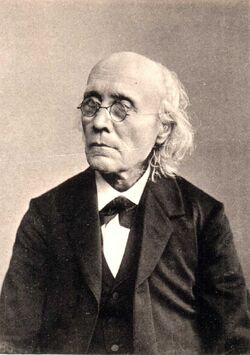Assessment |
Biopsychology |
Comparative |
Cognitive |
Developmental |
Language |
Individual differences |
Personality |
Philosophy |
Social |
Methods |
Statistics |
Clinical |
Educational |
Industrial |
Professional items |
World psychology |
Professional Psychology: Debating Chamber · Psychology Journals · Psychologists

Gustav Fechner
Gustav Theodor Fechner (April 19, 1801 – November 28, 1887), was a German experimental psychologist. A pioneer in experimental psychology, he inspired many 20th century scientists, including the philosopher Professor Gerardus Heymans.
He was born at Gross-Särchen, near Muskau, in Lower Lusatia, where his father was pastor. He was educated at Sorau and Dresden and at the University of Leipzig, the city in which he spent the rest of his life. In 1834 he was appointed professor of physics, but in 1839 contracted an eye disorder while studying the phenomena of colour and vision, and, after much suffering, resigned. Subsequently recovering, he turned to the study of the mind and its relations with the body, giving public lectures on the subjects dealt with in his books.
Works
- Das Büchlein vom Leben nach dem Tod (1836, 5th ed., 1903), which has been translated into English
- Nanna, oder über das Seelenleben der Pflanzen (1848, 3rd ed., 1903)
- Zendavesta, oder über die Dinge des Himmels und des lenseits (1851, 2nd ed. by Lasswitz, 1901)
- Uber die physikalische und philosophische Atomenlehre (1853, 2nd ed., 1864)
- Elemente der Psychophysik (1860, 2nd ed., 1889)
- Vorschule der Ästhetik (1876, 2nd ed., 1898)
- Die Tagesansicht gegenüber der Nachtansicht (1879).
He also published chemical and physical papers, and translated chemical works by J. B. Biot and L. J. Thénard from the French language. A different but essential side of his character is seen in his poems and humorous pieces, such as the Vergleichende Anatomie der Engel (1825), written under the pseudonym of "Dr. Mises."
Fechner's epoch-making work was his Elemente der Psychophysik (1860). He starts from the Spinozistic thought that bodily facts and conscious facts, though not reducible one to the other, are different sides of one reality. His originality lies in trying to discover an exact mathematical relation between them. The most famous outcome of his inquiries is the law known as Weber's or Fechner's law which may be expressed as follows:
- "In order that the intensity of a sensation may increase in arithmetical progression, the stimulus must increase in geometrical progression."
Though holding good within certain limits only, the law has been found immensely useful. Unfortunately, from the tenable theory that the intensity of a sensation increases by definite additions of stimulus, Fechner was led on to postulate a unit of sensation, so that any sensations might be regarded as composed of n units. Sensations, he argued, thus being representable by numbers, psychology may become an "exact" science, susceptible of mathematical treatment.
His general formula for getting at the number of units in any sensation is S = c log R, where S stands for the sensation, R for the stimulus numerically estimated, and c for a constant that must be separately determined by experiment in each particular order of sensibility. This reasoning of Fechner's has given rise to a great mass of controversy, but the fundamental mistake in it is simple. Though stimuli are composite, sensations are not. "Every sensation," says Professor James, "presents itself as an indivisible unit; and it is quite impossible to read any clear meaning into the notion that they are masses of units combined." Still, the idea of the exact measurement of sensation has been a fruitful one, and mainly through his influence on Wundt, Fechner was the father of that "new" psychology of laboratories which investigates human faculties with the aid of exact scientific apparatus.
Fechner also studied the still-mysterious perceptual illusion of Fechner color, whereby colors are seen in a moving pattern of black and white..
Though he had a vast influence in this special department, the disciples of his general philosophy were few. His world concept was highly animistic. He felt the thrill of life everywhere, in plants, earth, stars, the total universe. Man stands midway between the souls of plants and the souls of stars, who are angels. God, the soul of the universe, must be conceived as having an existence analogous to men. Natural laws are just the modes of the unfolding of God's perfection. In his last work Fechner, aged but full of hope, contrasts this joyous "daylight view" of the world with the dead, dreary "night view" of materialism. Fechner's work in aesthetics is also important. He conducted experiments to show that certain abstract forms and proportions are naturally pleasing to our senses, and gave some new illustrations of the working of aesthetic association. Fechner's position in reference to predecessors and contemporaries is not very sharply defined. He was remotely a disciple of Schelling, learnt much from Johann Friedrich Herbart and Christian Hermann Weisse, and decidedly rejected Georg Hegel and the monadism of Rudolf Hermann Lotze.
References
- This article incorporates text from the Encyclopædia Britannica, Eleventh Edition, a publication now in the public domain.
Modern discussions
Fechner's introduction of quantitative methods into psychology is discussed by
- Heidelberger, M. (2001) Gustav Theodor Fechner, Statisticians of the Centuries (ed. C. C. Heyde and E. Seneta) pp. 142-147. New York: Springer.
- Stephen M Stigler. The History of Statistics: The Measurement of Uncertainty before 1900, Cambridge, MA: Harvard University Press 1986. pp. 242-254.
External links
An extract from Elements of Psychophysics is available from the Classics in the History of Psychology website.
and an introduction by Robert H. Wozniak
bs:Gustav Fechner de:Gustav Theodor Fechner fr:Gustav Fechner pt:Gustav Theodor Fechner sk:Gustav Theodor Fechner
| This page uses Creative Commons Licensed content from Wikipedia (view authors). |